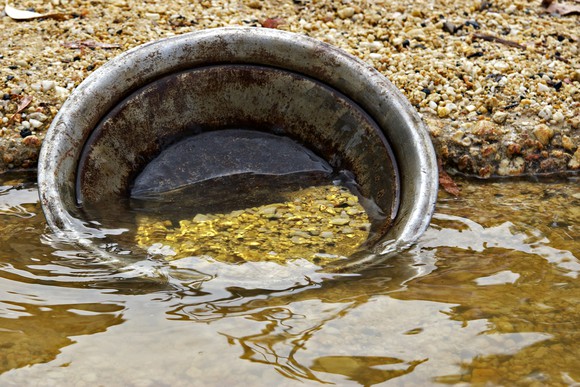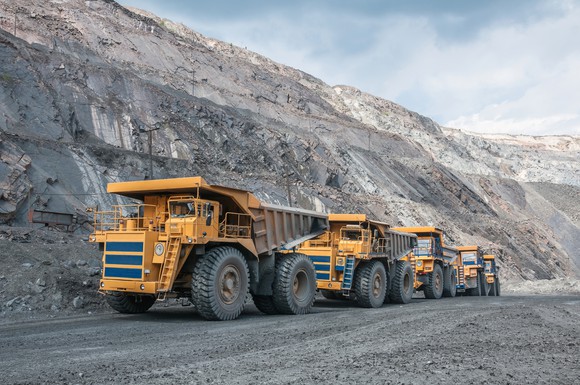
Image source: Getty Images.
Following three years of red, physical gold regained its shine in 2016 by adding roughly 9% in value from where it began the year. It's also begun 2017 on the right foot, with gold rising by about 4% to more than $1,195 an ounce.
However, when looking at the bigger picture, gold is significantly off of its highs this decade. After touching $1,900 per ounce in 2011, gold dipped as low as $1,050 per ounce in early 2016. Following the tumble gold prices took after Donald Trump was elected president, and the subsequent surge in both the U.S. dollar and Treasury yields, it looked quite possible that gold prices could revisit those levels. Though I personally remain quite bullish on gold, there's always a chance it could head back to $1,050, if not lower.
If there is a silver lining (or should I say golden lining) to the prospect of falling gold prices, it's that the vast majority of gold-mining companies have prudently cut their capital expenditures from where they were five years ago, and they've moved their focus to only their most profitable mines and projects. Doing so has slowed production growth for some of the largest gold miners, but it's also created a healthier companies that'll be able to withstand perhaps a 10% or even 20% additional drop in the price of gold.
Three types of gold stocks to avoid
Nonetheless, with gold still within striking distance of the $1,000 mark, there are certain types of gold stocks investors would probably be best off avoiding. Mind you, if gold were to get safely back above $1,300 per ounce and reestablish itself there for an extended period of time, my views would likely change. But, for the time being, the following three categories of gold miners probably shouldn't find their way into your portfolio.

Image source: Getty Images.
1. Developmental-stage gold miners
Arguably the most dangerous move you can make as a gold stock investor with the precious metal so far from its 2011 highs is to invest in a developmental-stage gold mining company like Seabridge Gold (SA +3.97%) or Northern Dynasty Minerals (NAK +2.31%).
Developmental-stage mining companies present a number of inherent dangers, the biggest of which being that they don't have the luxury of pulling levers when the price of gold dramatically shifts. Developmental miners have no revenue stream to speak of, and their entire valuation is based on the perceived value of the resources in the ground. If gold prices drop, they either have to stop the development of a mine, leaving the company with no revenue, or they're forced to proceed and hope that gold prices rebound. It's a bit akin to rolling the dice in Las Vegas. Already producing gold miners have the luxury of pulling back on capital expenditures and focusing on high grade projects. Long story short, developmental-stage miners have little to no flexibility.
The other issue is that the Federal Reserve is in a slow, but presumed to be ongoing, monetary tightening cycle. This means developmental-stage miners that need access to capital are going to find loans to be costlier than they were a few years prior.
Between the two miners listed above, Seabridge Gold is considerably closer to commencing the development of its core asset, the Kerr-Sulphurets-Mitchell (KSM) Project compared to Northern Dynasty Minerals with the Pebble Project in Alaska. Even so, KSM is still years away from production, assuming Seabridge obtains the necessary funding and moves forward with its development. As for Northern Dynasty, its latest 10-Q suggested that mining Pebble may not even be economically feasible at current prices, which is a horrifying thought for investors considering that the company's entire valuation is dependent on Pebble.
Long story short, avoid developmental-stage gold miners until we see a notable improvement in gold prices.

Image source: Getty Images.
2. African-based gold miners
With gold prices falling around $700 per ounce from their peak in a little less than six years, another group of stocks gold investors should avoid, or at least be extremely picky with or skeptical of, are gold miners based in Africa.
Why Africa? The big issue is that expenses for African miners are notoriously higher than anywhere else in the world. Companies mining in Africa run a higher risk of labor disputes, which can disrupt mining activity, and they also may struggle with political instability, which can lead to a mine shutdown. This isn't to say African-based gold miners can't be profitable or make significant strides in reducing their all-in sustaining costs (AISC), but they do tend to have higher AISCs than gold miners in other parts of the world.
A good example would be IAMGOLD (IAG +4.16%), which operates mines in Canada, Suriname, and Burkina Faso. The Essakane mine in Burkina Faso has been one of the company's greatest sources of production improvement in recent quarters, but it also could be its undoing.
For example, in late 2014, Burkina Faso's now-former president, Blaise Compaore, announced his resignation following violent protests after he attempted to extend his nearly three decades in charge. The upheaval of Compaore and the institution of an interim government sent a number of the country's mines into chaos, disrupting production. IAMGOLD, which has one of the highest AISCs of any gold miner, at $1,075 (based on the midpoint), could be especially vulnerable if there's so much as a hiccup with Essakane's production.
Unless IAMGOLD's margin increases, this is a gold miner probably worth avoiding.

Image source: Getty Images.
3. Heavily indebted gold miners
Finally, investors would probably be wise to keep their distance from gold miners that are swimming in debt. A highly indebted miner presumably has reduced financial flexibility, and it also has to contend with the Federal Reserve's tightening monetary policy. The opportunity to refinance debt for less is pretty much being taken away, and any subsequent loans are probably going to be costlier than previous loans.
For a good example, look no further than Golden Star Resources (GSS +0.00%), which offers the dreaded double-whammy. First, Golden Star's two mines are located in Africa. Thus, it probably comes as no surprise that Golden Star's AISC is considerably higher than many of its peers. For the third quarter, Golden Star Resources wound up reporting an AISC of $1,153 an ounce, which is actually higher than where physical gold ended 2016.
The other, potentially bigger, issue is that Golden Star Resources ended the third quarter with more than $111 million in debt compared to $17 million in cash. That may not sound like a crippling amount of debt, but Golden Star is reliant on just its two African mines, and it doesn't even own a 100% share in its Wassa and Prestea mines. In exchange for $150 million from Royal Gold (RGLD +1.82%) to develop both underground mines, Golden Star divested a minority stream of production to Royal Gold. This makes rising gold prices especially important to the long-term health of Golden Star Resources, and it's a good reason that $1,200 gold might make Golden Star Resources a stock worth passing on.
Though it's always possible that gold miners falling into one or more of these categories could head higher, there's a good chance you have more attractive gold-mining investment options at your disposal.
